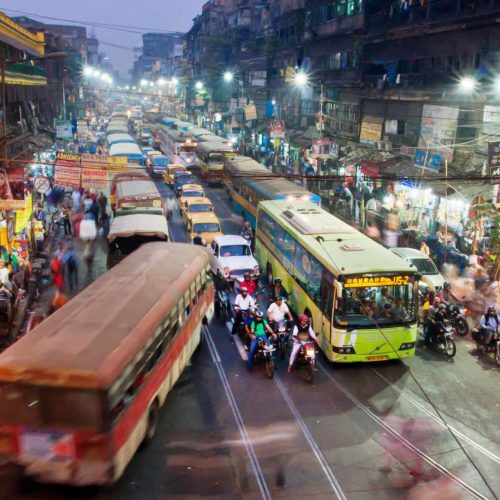mixed use commuters travelling by bus in the pandemic era

Taking the Bus to Zero-Emissions Mobility
Public transit already provides far and away the lowest emissions per trip, other than walking or pedaling, and the continued electrification of buses is a key catalyst for reaching zero tailpipe emissions for both passenger and freight mobility. As we emerge from the pandemic, transit cannot be allowed to die under a false narrative about a new normal—a return to single-occupant vehicles and the increasing congestion and tailpipe pollution that single-occupancy trips bring.
Transit is a vital piece of the carbon-free mobility puzzle, and bus electrification is an essential first step. Why? Because despite how desirable and necessary trains are to connect economic and recreational hubs in the United States, light rail will take a decade to site and build. Even then, it takes years more for infill development to create vibrant transit-oriented communities. Buses and shuttles, on the other hand, are electrifiable today and can serve our existing communities quite well, including in times of disaster. Buses also provide adaptability in where and when they run and how they are used.
Electrifying buses won’t be cheap or easy, until it is. Recall the wave of renewable energy portfolio standards in the mid-2000s, calling for modest amounts of clean energy on the grid. Fifteen years later, not only is renewable energy cheaper than traditional fuel, it’s also straightforward to finance and simple to connect to the grid.
Yes, this required technological breakthroughs, innovative financing, and, importantly, new techniques in balancing the system. Each of those advances seemed impossible initially but proved doable with human ingenuity. With electric buses we are far beyond the starting line and the finish is in sight—beyond 2030 there shouldn’t be another diesel bus sold, just like we’ll never build another coal plant after 2020.
Factoid from pre-pandemic times in the United States: 26 million schoolchildren rode the bus every day (on 480,000 school buses); 22 million adults commuted by transit every day (on 130,000 buses); another 100 million commuters took personal vehicles each day (in 100 million cars and trucks); and 2.6 million Americans boarded planes (on 44,000 daily flights). Considering these numbers, electrifying 610,000 school buses and transit vehicles that ferry 48 million people daily is a very effective use of time and money toward clean mobility while we work to encourage at least 50 million individuals to buy an electric vehicle this decade.
Market Interventions and Funding
- In 2021, transit operations need an infusion of additional federal financial support to save transit from languishing due to empty state and local coffers.
- By 2022, the Federal Highway Administration (FHWA) and Federal Transit Administration (FTA) should reallocate half of capital grant funding to bus electrification, including resiliency, with a clear line of sight to eliminate the funding of petroleum-fueled buses by the end of the decade.
- National Green Bank and public-private partnership statutes in every state will stimulate private capital to fund the necessary charging infrastructure for buses, as well as leverage expertise in private industry to solve challenges in transitioning to this new fuel.
- State transportation agencies should continue their evolutionary thinking around mobility (passenger and freight), beyond a roads-and-bridges paradigm, and should learn from their leading city DOTs.
- Local urban planners must adopt progressive concepts such as transit-oriented development and 15-minute neighborhoods, which allow residents choice in mobility modes. Timing is of the essence for novel options as the commercial real-estate industry enters a slow recovery.
- Utilities should support bus electrification first and foremost given the intrinsic equitability of public and pupil transit, the high daily utilization that will in part drive down electric rates, and the reality that shared rides reduce carbon per trip far faster than electrifying personal vehicles.
Transition Planning for Fleet Electrification
Electric buses are heavy-duty vehicles, and the lessons learned and tools developed for this transition will aid trucking electrification, which has just begun. Bus operations offer a set of well-defined routes, daily repetition, real-time telematics, and commitments to electrification. Yet for transit operators, electrification can seem like an impossible task. How can transit plan for 100 percent fleet electrification over 20 years, with only today’s known capabilities and limited experience for most transit agencies?
From Pilots to Scale
Think in phases and use scenario planning to allow for knowledge gained to inform the next phase. There is no doubt that operators must plan for and build infrastructure at least one step in front of electric bus orders and planning 20 years in the future will be better informed after initial electric bus deployments are well under way.
Develop a pilot to scale stage-gate methodology that identifies what must be achieved in order to implement the next phase. Vehicle range over a full shift is one obvious example. Defining a set of knowns and unknowns is important for clarifying hypotheses to test, which helps crystallize what will inhibit or allow expanded electric deployment. This approach will also illuminate that which does not matter in the early phases and therefore doesn’t need to be addressed just yet.
Operating electric buses is measured by service quality—reliability that riders can depend on. Let’s recognize that operating a fleet of buses across many routes with varying demand over the day is far more complicated than the casual observer would think. To plan for and operate electric buses requires new tools, or at least added capabilities in system planning, bus/driver scheduling, charging management, and dispatch operations. This is an emerging practice that so far has focused on fitting electric buses on existing routes and managing the charging scheme and cost of electricity.
Similar to challenges for the electric grid caused by intermittent renewable generation, electric buses don’t go as far and need more downtime to recharge than diesel buses need to refuel. Operating assets with high flexibility now becomes operating assets with more constraints.
Economics That Catalyze
The real question about bus electrification is one of economics: How can transit operators borrow against future savings to address the upfront price premium of buses and the startup capital costs of infrastructure and tooling? To restate the obvious, electric buses should cost less to fuel, and maintenance costs are expected to be lower due to fewer moving parts and fluids to change. Yet transit agencies in the United States, which are accustomed to federally subsidized capital expenditures and self-funded operational expenditures, do not have the accounting mechanisms that recognize long-term operational savings.
Economic incentives currently focus on reducing the upfront capital premium of the new technology, and at the vanguard are third-party loans for the battery portion of the cost with expected second-life use of the battery asset. This arrangement is helpful for transit agencies that are not dependent on federal capital grants, such as airports and universities, because it creates price parity with diesel.
Those dependent on federal grants only pay 15 percent of the cost of an electric bus ($150,000) compared with 20 percent of the cost of a diesel bus ($100,000), and therefore the incremental cash required is not the full price gap. Unfortunately, the federal grants that cover these purchases are extremely limited. Another approach that works for all transit agencies is for the electric utility to provide on-bill financing for the bus battery, which is repaid from savings on diesel fuel.
This price premium as it exists today should be considered the cost of a zero-emissions commitment. This premium is temporary and is expected to subside during the first half of this decade.
The imminent economic challenge is infrastructure, including the installation of charging depots, the cost of electricity as fuel, and the cost of planning and new software. These are upfront costs that extend across the bus fleet, and within a capital-constrained environment require innovative financing to help transit rapidly prepare for significant electrification.
Analogous financing arrangements already exist for other sectors. Take for instance energy efficiency financing of performance contracting, which enables no-cost building retrofits to be repaid through energy cost savings, or property-assessed clean energy finance that enables no-cost renewable energy. Fleet electrification needs the charging depot equivalent of a power purchase agreement (PPA) to remove the burden of electricity as fuel from the transit operator and allow them to focus on reliable service and operating electric buses.
PPAs (power purchase agreements) for transit rely on three things: state statutes that allow public-private partnerships for public agencies, green banks to provide concessional capital alongside private investment, and project sponsor companies motivated to minimize the cost of required infrastructure and manage the pass-through cost of electricity for the transit agency. The topic of PPAs for transit and fleets is a subject we will explore in a future blog post.
Bus electrification is neither cheap nor easy today, but with each step our journey to zero emissions is that much closer.
Let us remember that anything new or unknown is challenging when considering all the questions to be addressed. If we understand when those questions will be important to answer, they become less daunting. In summary:
- Bus electrification, and transit generally, is essential to reducing climate emissions from passenger mobility
- Bus electrification planning must be taken in phases, not all at once
- Bus electrification allows for innovative financing and can stimulate private investment in fleet electrification
- Bus electrification is the vanguard that will guide medium- and heavy-duty truck fleets


